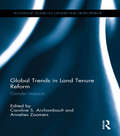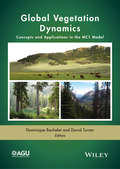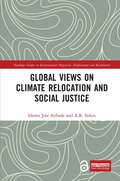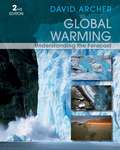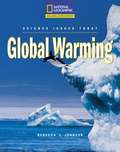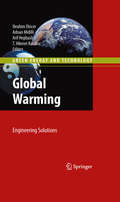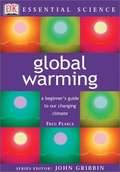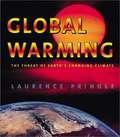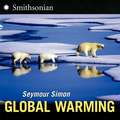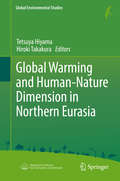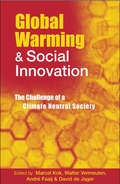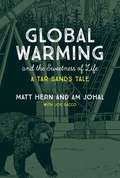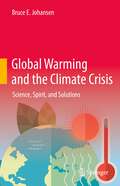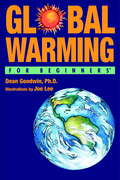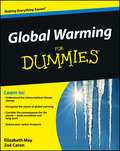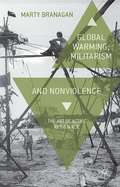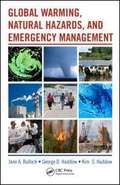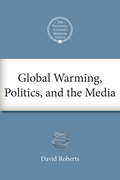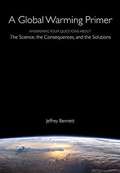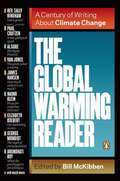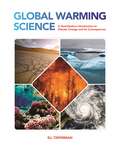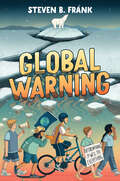- Table View
- List View
Global Trends in Land Tenure Reform: Gender Impacts (Routledge ISS Gender, Sexuality and Development Studies)
by Caroline S. Archambault Annelies ZoomersThis book explores the gendered dimensions of recent land governance transformations across the globe in the wake of unprecedented pressures on land and natural resources. These complex contemporary forces are reconfiguring livelihoods and impacting women’s positions, their tenure security and well-being, and that of their families. Bringing together fourteen empirical community case studies from around the world, the book examines governance transformations of land and land-based resources resulting from four major processes of tenure change: commercial land based investments, the formalization of customary tenure, the privatization of communal lands, and post-conflict resettlement and redistribution reforms. Each contribution carefully analyses the gendered dimensions of these transformations, exploring both the gender impact of the land tenure reforms and the social and political economy within which these reforms materialize. The cases provide important insights for decision makers to better promote and design an effective gender lens into land tenure reforms and natural resource management policies. This book will be of great interest to researchers engaging with land and natural resource management issues from a wide variety of disciplines, including anthropology, sociology, development studies, and political science, as well as policy makers, practitioners, and activists concerned with environment, development, and social equity.
Global Vegetation Dynamics: Concepts and Applications in the MC1 Model
by Dominique Bachelet David TurnerGlobal Vegetation Dynamics: Concepts and Applications in MC1 model describes the creation in the mid 1990s, architecture, uses, and limitations of the MC1 dynamic global vegetation model (DGVM) that is being used by an increasing number of research groups around the world. The scientific foundation of most models is often poorly documented and difficult to access, and a centralized source of information for MC1, including the complete list of over eighty papers and reports with MC1 results will be useful to scientists and users who want to better understand the model and the output it generates. Global Vegetation Dynamics: Concepts and Applications in MC1 model will be a valuable resource for students and researchers in the fields of climate change science, conservation science, biogeochemistry and ecology, as well as for land managers looking for a better understanding of the projections of climate change impacts and of the tools that have been developed to produce them.he fire model, which was the first of its kind among dynamic global vegetation models; a brief history of the model creation; summaries of model results at the continental (North America), regional (Pacific Northwest), and local (Wind Cave NP and Sierra Nevada) scales; a description of its use to transform a state and transition model into its climate-smart version to help managers prepare for climate change challenges; and the description of an on-line tool (databasin.org) that provides snapshots as well as animated time series of its results. Finally, a complete bibliography (as of spring 2015) lists over 80 publications that include MC1 results. Global Vegetation Dynamics: Concepts and Applications in the MC1 model will be a valuable resource for students and researchers in the fields of climate change science, conservation science, and biogeochemistry and ecology, as well as for land managers looking for a better understanding of the projections of climate change impacts and of the tools that have been developed to produce them.
Global Views on Climate Relocation and Social Justice: Navigating Retreat (Routledge Studies in Environmental Migration, Displacement and Resettlement)
by Idowu Jola Ajibade A. R. SidersThis edited volume advances our understanding of climate relocation (or planned retreat), an emerging topic in the fields of climate adaptation and hazard risk, and provides a platform for alternative voices and views on the subject. As the effects of climate change become more severe and widespread, there is a growing conversation about when, where and how people will move. Climate relocation is a controversial adaptation strategy, yet the process can also offer opportunity and hope. This collection grapples with the environmental and social justice dimensions from multiple perspectives, with cases drawn from Africa, Asia, Australia, Oceania, South America, and North America. The contributions throughout present unique perspectives, including community organizations, adaptation practitioners, geographers, lawyers, and landscape architects, reflecting on the potential harms and opportunities of climate-induced relocation. Works of art, photos, and quotes from flood survivors are also included, placed between sections to remind the reader of the human element in the adaptation debate. Blending art – photography, poetry, sculpture – with practical reflections and scholarly analyses, this volume provides new insights on a debate that touches us all: how we will live in the future and where? Challenging readers’ pre-conceptions about planned retreat by juxtaposing different disciplines, lenses and media, this book will be of great interest to students and scholars of climate change, environmental migration and displacement, and environmental justice and equity.
Global Warming: Understanding the Forecast
by David Archer<P>Archer's Global Warming: Understanding the Forecast 2nd Edition, is the first real text to present the science and policy surrounding climate change at the right level. Accompanying videos, simulations and instructional support makes it easier to build a syllabus to improve and create new material on climate change. Archer's polished writing style makes the text entertaining while the improved pedagogy helps better understand key concepts, ideas and terms. <P>This edition has been revised and reformulated with a new chapter template of short chapter introductions, study questions at the end, and critical thinking puzzlers throughout. Also a new asset for the BCS was created that will give ideas for assignments and topics for essays and other projects. Furthermore, a number of interactive models have been built to help understand the science and systems behind the processes.
Global Warming
by John HoughtonThis work is a full survey of the present state of knowledge on global warming, and what can be done about it. The information and interpretation is not just one man's view, but represents the common mind of the scientific community. Many of the charts and diagrams are generated by the Met Office computer. Sir John Houghton is the author of The Physics of Atmospheres and Does God Play Dice?.
Global Warming
by Sir John HoughtonJohn Houghton's market-leading textbook is now in full color and includes the latest IPCC findings, making it the definitive guide to climate change. Written for students across a wide range of disciplines, its simple, logical flow of ideas gives an invaluable grounding in the science and impacts of climate change and highlights the need for action on global warming. Is there evidence for climate changing due to human activities? How do we account for recent extremes of weather and climate? Can global electricity provision and transport ever be carbon free? Written by a leading figure at the forefront of action to confront humanity's most serious environmental problem, this undergraduate textbook comprehensively explores these and other issues, allowing students to think through the problem, assess the data and draw conclusions on the action that should be taken, by governments, by industry and by each and every one of us.
Global Warming (Nonfiction Reading And Writing Workshops)
by Rebecca Johnson National Geographic Learning StaffDiscover the science behind global warming, its causes, and possible effects. Learn how human activities affect global temperatures and explore the good news and the bad news about our warming world.
Global Warming
by Adnan Midilli T. Hikmet Karakoc Ibrahim Dincer Arif HepbasliGlobal Warming: Engineering Solutions goes beyond the discussion of what global warming is, and offers complete concrete solutions that can be used to help prevent global warming. Innovative engineering solutions are needed to reduce the effects of global warming. Discussed here are proposed engineering solutions for reducing global warming resulting from carbon dioxide pollution, poor energy and environment policies and emission pollution. Solutions discussed include but are not limited to: energy conversion technologies and their advantages, energy management and conservation, energy saving and energy security, renewable and sustainable energy technologies, emission reduction, sustainable development; pollution control and measures, policy development, global energy stability and sustainability.
Global Warming: A Beginner's Guide to Our Changing Climate
by Fred Pearce John GribbinBig ideas made simple -- six books in an incredible new series that explains important scientific ideas more clearly than ever before. Climate change resulting from an increase in greenhouse gases is perhaps the greatest threat to our planet's future. Here, Fred Pearce examines the causes and dramatic effects, and what can be done to remedy the situation -- before it's too late. This stimulating new series uses an innovative mix of graphics, artwork, and photographs to explain and illuminate the most important scientific topics of the day. Unique in popular science guides, Essential Science uses bright, full-color images to make traditionally "difficult" subjects more accessible. Each title focuses on a scientific or technological topic that is currently provoking debate and is likely to have a widespread impact on our lives. Lively, readable text from top science writers ensures all readers -- from 14+ schoolchildren to academics -- gain a full understanding of the facts and related issues. Under the direction of renowned science writer John Gribbin, expert authors describe, in lively, jargon-free text, the principles and discoveries behind each subject, summarize what is currently known, and predict future issues and trends.
Global Warming
by Susan PhilipOur earth is getting hotter and hotter. As a result, the polar ice caps are melting, the water levels in the oceans are rising, soon low-lying, small islands will vanish, there will be less and less rainfall so crops will die, and we humans will face shortage of food and drinking water. Animals and birds will soon start disappearing. If you thought this was the script of some new sci-fi movie, you are mistaken. All this is already happening as a result of Global Warming-the new threat Planet Earth is facing. This book is all about this scary natural phenomenon which is worrying scientists and countries around the world.
Global Warming: The Threat of Earth's Changing Climate
by Laurence PringleIt's not your imagination: Earth is getting warmer. Global warming is perhaps the most prominent environmental issue of the past decade. Award-winning writer Laurence Pringle describes the causes of this worldwide trend, exploring its past, present, and potential future damage to our climate, ecology, and economy. He also offers practical solutions that will help avert a global disaster of our own making.
Global Warming (Smithsonian-science)
by Seymour SimonAward-winning science writer Seymour Simon gives you a full-color photographic introduction to the causes and effects of global warming and climate change. <P><P>Earth's climate has always varied, but it is now changing more rapidly than at any other time in recent centuries. The climate is very complex, and many factors play important roles in determining how it changes. Why is the climate changing? Could Earth be getting warmer by itself? Are people doing things that make the climate warmer? <P><P>Supports the Common Core State Standards
Global Warming and Human - Nature Dimension in Northern Eurasia
by Tetsuya Hiyama Hiroki TakakuraThis book describes the current environmental changes due to global warming in northern Eurasia, especially focusing on eastern Siberia. Spring flooding, ice-jam movements, and monitoring using remote sensing are included. Additionally, current reindeer herding of indigenous peoples in Siberia and related environmental changes such as waterlogging, rising temperatures, and vegetation changes are addressed. As a summary, the book also introduces readers to adaptation strategies at several governmental levels. The book primarily focuses on 1) introducing readers to global warming and human/nature dynamics in Siberia, with special emphasis on humidification of the region in the mid-2000s, and 2) describing social adaptation to the changing terrestrial ecosystem, with an emphasis on water environments. Adaptation strategies based on vulnerability assessments of environmental changes in northern Eurasia are crucial topics for intergovernmental organizations, such as the IPCC (Intergovernmental Panel on Climate Change). Thus, the book offers a valuable resource not only for environmental researchers but also for several stakeholders regarding global environmental change.
Global Warming and Social Innovation: The Challenge of a Climate Neutral Society
by Andre Faaij David Jager Marcel KokSocieties need to reduce emissions of greenhouse gases by 80 per cent in order to counter the risks of climate change. This study envisions a climate neutral society - one where the output of polluting gases is minimised by social innovations set up in households, by local authorities, through developments in information and communications technologies and dematerialization, and through the shift towards product service systems and emissions trading. The work discusses the possibilities for steering and orchestrating this long-term transition towards a climate-friendly society, mapping paths through current dilemmas in climate policy and exploring the legal issues of making this transition.
Global Warming And The Sweetness Of Life: A Tar Sands Tale
by Matt Hern Am Johal Joe SaccoConfounded by global warming and in search of an affirmative politics that links ecology with social change, Matt Hern and Am Johal set off on a series of road trips to the tar sands of northern Alberta—perhaps the world's largest industrial site, dedicated to the dirty work of extracting oil from Alberta's vast reserves. Traveling from culturally liberal, self-consciously “green” Vancouver, and aware that our well-meaning performances of recycling and climate-justice marching are accompanied by constant driving, flying, heating, and fossil-fuel consumption, Hern and Johal want to talk to people whose lives and fortunes depend on or are imperiled by extraction. They are seeking new definitions of ecology built on a renovated politics of land. Traveling with them is their friend Joe Sacco—infamous journalist and cartoonist, teller of complex stories from Gaza to Paris—who contributes illustrations and insights and a chapter-length comic about the contradictions of life in an oil town. The epic scale of the ecological horror is captured through an series of stunning color photos by award-winning aerial photographer Louis Helbig. <P><P> Seamlessly combining travelogue, sophisticated political analysis, and ecological theory, speaking both to local residents and to leading scholars, the authors propose a new understanding of ecology that links the domination of the other-than-human world to the domination of humans by humans. They argue that any definition of ecology has to start with decolonization and that confronting global warming requires a politics that speaks to a different way of being in the world—a reconstituted understanding of the sweetness of life.
Global Warming and the Climate Crisis: Science, Spirit, and Solutions
by Bruce E. JohansenThis textbook introduces readers to basic scientific principles of climate change. Based on extensive empirical evidence, it explains weather events that indicate climate change’s evolution and presents important topics connected to climate change, such as political controversies, climate policy, as well as Native American perspectives. Finally, it presents attempted solutions, including policy recommendations and technological proposals for necessary changes in our world.Providing a well-written and easy-to-follow overview of knowledge of science-based geophysical facts, including thermodynamics, the book puts a strong emphasis on why expeditious action on global warming is urgent. The book also explains why smart greenhouse-gas reduction strategies will ignite economic growth, generate new domestic jobs, protect public health, and strengthen energy security.Not assuming a scientific background on the part of the reader, Global Warming and the Climate Crisis: Science, Spirit, and Solutions offers an ideal supplemental reading in many types of courses in Earth sciences, climate policy, climate change sciences, as well as politics of climate change, from high school through undergraduate. General readers also will benefit from its treatment of this very important and timely issue.
Global Warming for Beginners
by Dean GoodwinThe science is in: Global warming is for real. But what does it all really mean, and what can or should we do about it? This clear, fluid narrative by a leading scientist and educator takes a scrupulously balanced approach in explaining for the reader the history of global climate monitoring and change, and the who’s, how’s, what’s, when’s, where’s and why’s of the interaction between human activity and recent trends in the Earth’s climate. Global Warming For Beginners is organized into five compelling sections: Global Warming, An Introduction The Cause The Consequences The Solutions What Steps Can I Take? Working from the premise that no one can do everything but everyone can do something, Goodwin challenges readers with experiments they can conduct to gain a better understanding of the science underlying the problems facing our planet, and concludes with a list of fifty easy actions people can choose from to start doing their part in the effort to slow or stop global warming. As with all For Beginners titles, this volume is illustrated throughout with entertaining drawings that help readers understand and retain the information in Goodwin’s lively and comprehensive text.
Global Warming For Dummies
by Elizabeth May Zoe CaronGet positive suggestions for practical solutions to this heated issue. Hotly debated in the political arena and splashed across the media almost 24/7, global warming has become the topic of the moment. Whatever one's views on its cause, there is no denying that the earth's climate is changing, and people everywhere are worried. Global Warming For Dummies sorts out fact from fiction, explaining the science behind climate change and examining the possible long-term effects of a warmer planet. This no-nonsense yet friendly guide helps you explore solutions to this challenging problem, from what governments and industry can do to what you can do at home and how to get involved.
Global Warming, Militarism and Nonviolence
by Marty BranaganMilitarism is the elephant in the room of global warming. Of all government sectors, 'Defence' has the highest carbon footprint and expenditure, yet has largely been exempt from international scrutiny and regulation. Marty Branagan uses Australian and international case studies to show that nonviolence is a viable alternative to militarism for national defence and regime change. 'Active resistance', initiated in Australian environmental blockades and now adopted globally, makes the song 'We Shall Not Be Moved' much more realistic, as activists erect tripod villages, bury, chain and cement themselves into the ground, and 'lock-on' to machinery and gates. Active resistance, 'artistic activism', and use of new information and communication technologies in movements such as the Arab Spring and 'Occupy' demonstrate that nonviolence is an effective, evolving praxis.
Global Warming, Natural Hazards, And Emergency Management
by George Haddow Jane A. Bullock Kim HaddowScientists predict the earth is facing 40-to-60 years of climate change, even if emissions of carbon dioxide and other global warming gases stopped today. One inevitable consequence of the greenhouse gases already in the atmosphere will be an increase in the frequency and severity of natural disaster events. Global Warming, Natural Hazards, and Emergency Management documents the imperative need for communities to prepare for the coming effects of climate change and provides a series of in-depth, road-tested recommendations on how to reduce risks for communities and businesses. Frontline Advice for Increasing Defenses and Reducing Impacts of Global Warming Authored and edited by emergency management and environmental protection professionals from the Federal Emergency Management Agency (FEMA) and the Sierra Club, this book offers case histories from communities across America that have successfully reduced the extent and consequences of natural disasters. These examples are becoming increasingly important to understand and replicate as the risks to communities created by a changing climate rise. This book recognizes three fundamental principles essential to developing a disaster-prevention strategy: The protection of natural systems is an important security measure The reduction of disaster risk, not just response, is of great importance Local communities must take the lead in prevention efforts Provides Local Governments with Replicable Case Histories of Hazard Mitigation Efforts This no-nonsense reference is a procedural roadmap for emergency managers, policy makers, and community officials. It explains how to develop community partnerships among a myriad of stakeholders; identifies staffing and resource requirements for successful programs; and provides a step-by-step demonstration of the disaster-planning process at the community level.
Global Warming, Politics, and the Media
by David Roberts Eban GoodsteinOn September 21, 2011, David Roberts participated in The National Climate Seminar, a series of webinars sponsored by Bard College's Center for Environmental Policy. The online seminars provide a forum for leading scientists, writers, and other experts to talk about critical issues regarding climate change. The series also opens a public conversation, inviting participants to ask questions and contribute their own thoughts. Roberts is a Senior Staff Writer at Grist, one of the web's most popular sites for environmental news and commentary, so he is distinctively qualified to discuss the relationship between global warming, politics, and the media. In his lecture, Roberts argued that environmentalists' traditional criticism of climate change coverage--namely that journalists describe global warming as a debatable theory rather than as fact--is no longer the issue. Most media accept the reality of climate change--but it is treated as a specialty issue, rather than as a phenomenon that affects myriad aspects of life. The seminar focused on how to change that perception--how to make climate a backdrop to the political debates that affect real change. This E-ssentialis an edited version of Roberts' talk and the subsequent question and answer session. While some material has been cut and some language modified for clarity, the intention was to retain the substance of the original discussion.
A Global Warming Primer: Answering Your Questions About The Science, The Consequences, And The Solutions
by Jeffrey BennettIs human-induced global warming a real threat to our future? Most people will express an opinion on this question, but relatively few can back their opinions with solid evidence. Many times we've even heard pundits say "I am not a scientist" to avoid the issue altogether. But the truth is, the basic science is not that difficult. Using a question and answer format, this book will help readers achieve three major goals: To see that anyone can understand the basic science of global warming; To understand the arguments about this issue made by skeptics, so that readers will be able to decide for themselves what to believe; To understand why, despite the "gloom and doom" that often surrounds this topic, the solutions are ones that will not only protect the world for our children and grandchildren, but that will actually lead us to a stronger economy with energy that is cheaper, cleaner, and more abundant than the energy we use today.
The Global Warming Reader: A Century of Writing About Climate Change
by Bill MckibbenOur most widely respected environmental writer brings together the essential voices on global warming, from its 19th-century discovery to the present. With the rise of extreme weather events worldwide--witness the devastation wrought by Hurricanes Sandy, Irene, and Katrina, and the sustained drought across the American West--global warming has become increasingly difficult to deny. What is happening to our planet? And what can we do about it? The Global Warming Reader provides more than thirty-five answers to these burning questions, from more than one hundred years of engagement with the topic. Here is Elizabeth Kolbert's groundbreaking essay "The Darkening Sea," Michael Crichton's skeptical view of climate change, George Monbiot's biting indictment of those who are really using up the planet's resources, NASA scientist James Hansen's testimony before the U. S. Congress, and clarion calls for action by Al Gore, Arundhati Roy, Naomi Klein, and many others. The Global Warming Reader is a comprehensive resource, expertly edited by someone who lives and breathes this defining issue of our time.
Global Warming Science: A Quantitative Introduction to Climate Change and Its Consequences
by Eli TzipermanA quantitative, broad, hands-on introduction to the cutting-edge science of global warmingThis textbook introduces undergraduates to the concepts and methods of global warming science, covering topics that they encounter in the news, ranging from the greenhouse effect and warming to ocean acidification, hurricanes, extreme precipitation, droughts, heat waves, forest fires, the cryosphere, and more. This book explains each of the issues based on basic statistical analysis, simple ordinary differential equations, or elementary chemical reactions. Each chapter explains the mechanisms behind an observed or anticipated change in the climate system and demonstrates the tools used to understand and predict them. Proven in the classroom, Global Warming Science also includes “workshops” with every chapter, each based on a Jupyter Python notebook and an accompanying small data set, with supplementary online materials and slides for instructors. The workshop can be used as an interactive learning element in class and as a homework assignment.Provides a clear, broad, quantitative yet accessible approach to the science of global warmingEngages students in the analysis of climate data and models, examining predictions, and dealing with uncertaintyFeatures workshops with each chapter that enhance learning through hands-on engagementComes with supplementary online slides, code, and data filesRequires only elementary undergraduate-level calculus and basic statistics; no prior coursework in science is assumedSolutions manual available (only to instructors)
Global Warning
by Steven B. FrankA group of 12-year-old friends concerned about climate change proposes a new way to save the earth: amending the U.S. Constitution. Their project propels these activists on an amazing journey across America—and all the way to Norway—with plenty of outside-the-box hijinks and civil disobedience, as they work to save the planet and their futures on it. For sixth grader Sam Warren and his friends Catalina, Alistair, Jaesang, and Zoe, the effects of climate change are too pressing to ignore. Adults don’t seem to be up to the challenge of taking action to make real change, but kids know it’s their futures on the line. If their parents, teachers, and government officials won’t step up well, then, they will! And these young people will stop at nothing to save the planet and their futures on it. With a little help from a retired kids' rights lawyer and a grandma who knows how to march, they are ready to think big: Constitutional amendment big. But can a bunch of 12-year-olds really draft an amendment that protects the planet, get it to pass in Congress, and change enough hearts and minds across the country to get it ratified before the clock runs out? Steven B. Frank crafts another funny and fast-paced story of heightened-reality wish-fulfillment, loaded with the witty patter of smart kids, in this book that reads like Aaron Sorkin for middle grade and plumbs the complexities of the Constitution and the critical turning point of global climate change.
